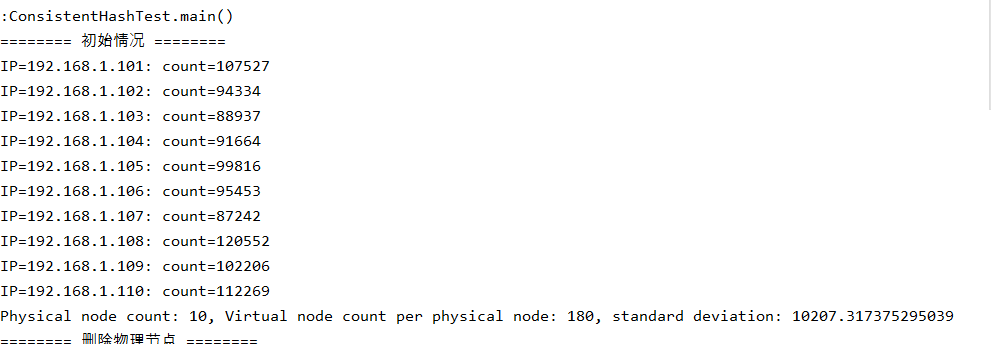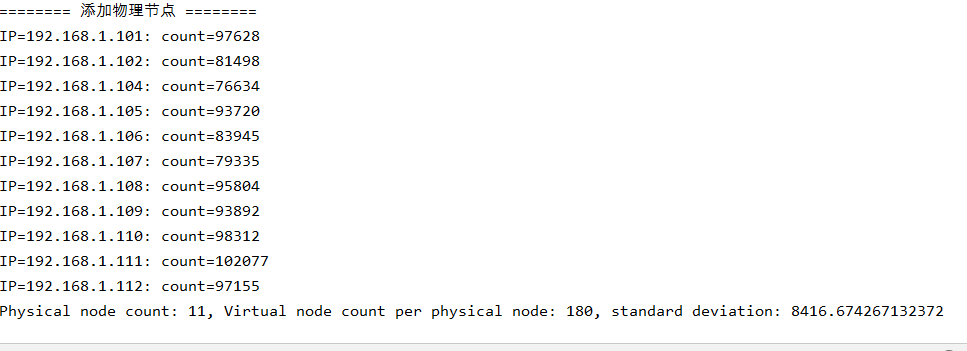架构师训练营 - 作业 5
发布于: 2020 年 07 月 08 日
作业:用你熟悉的语言实现一致性 hash 算法,编写测试用例测试此算法,测试 100 万 KV 数据,10 个服务器节点的情况下,计算服务器分布数量的标准差,以评估算法的存储负载的不均衡性
/** * Create By lhu on 7/7/2020 */public class ConsistentHashTest { // 物理节点 private Set<String> physicalNodes = new TreeSet<String>() {};
//虚拟节点 private int VIRTUAL_COPIES = 150; // 物理节点至虚拟节点的复制倍数 private TreeMap<Long, String> virtualNodes = new TreeMap<>();
/** * hash算法,输出64位的值 */ public long hash(final byte[] data, int length, int seed) { final long m = 0xc6a4a7935bd1e995L; final int r = 47; long h = (seed & 0xffffffffl) ^ (length * m); int length8 = length / 8;
for (int i = 0; i < length8; i++) { final int i8 = i * 8; long k = ((long) data[i8 + 0] & 0xff) + (((long) data[i8 + 1] & 0xff) << 8) + (((long) data[i8 + 2] & 0xff) << 16) + (((long) data[i8 + 3] & 0xff) << 24) + (((long) data[i8 + 4] & 0xff) << 32) + (((long) data[i8 + 5] & 0xff) << 40) + (((long) data[i8 + 6] & 0xff) << 48) + (((long) data[i8 + 7] & 0xff) << 56); k *= m; k ^= k >>> r; k *= m; h ^= k; h *= m; }
switch (length % 8) { case 7: h ^= (long) (data[(length & ~7) + 6] & 0xff) << 48; case 6: h ^= (long) (data[(length & ~7) + 5] & 0xff) << 40; case 5: h ^= (long) (data[(length & ~7) + 4] & 0xff) << 32; case 4: h ^= (long) (data[(length & ~7) + 3] & 0xff) << 24; case 3: h ^= (long) (data[(length & ~7) + 2] & 0xff) << 16; case 2: h ^= (long) (data[(length & ~7) + 1] & 0xff) << 8; case 1: h ^= (long) (data[length & ~7] & 0xff); h *= m; }
h ^= h >>> r; h *= m; h ^= h >>> r; return h; }
public long hash(final byte[] data, int length) {
return hash(data, length, 0xe17a1465);
}
public long Hash(final String data) { byte[] bytes = toBytesWithoutEncoding(data); return hash(bytes, bytes.length); }
private byte[] toBytesWithoutEncoding(String str) { int len = str.length(); int pos = 0; byte[] buf = new byte[len << 1]; for (int i = 0; i < len; i++) { char c = str.charAt(i); buf[pos++] = (byte) (c & 0xFF); buf[pos++] = (byte) (c >> 8); } return buf; }
// 根据物理节点,构建虚拟节点映射表,使用默认的虚拟节点数量1 public ConsistentHashTest(Set<String> physicalNodes) { this(physicalNodes,0); }
// 根据物理节点,构建虚拟节点映射表 public ConsistentHashTest(Set<String> physicalNodes, int virtualCopyCount) { for (String nodeIp : physicalNodes) { addPhysicalNode(nodeIp); } if (virtualCopyCount>=1) VIRTUAL_COPIES = virtualCopyCount; }
// 添加物理节点 public void addPhysicalNode(String nodeIp) { for (int idx = 0; idx < VIRTUAL_COPIES; ++idx) { long hash = Hash(nodeIp + "#" + idx); virtualNodes.put(hash, nodeIp); } physicalNodes.add(nodeIp); }
// 删除物理节点 public void removePhysicalNode(String nodeIp) { for (int idx = 0; idx < VIRTUAL_COPIES; ++idx) { long hash = Hash(nodeIp + "#" + idx); virtualNodes.remove(hash); } physicalNodes.remove(nodeIp); }
// 查找对象映射的节点 public String getObjectNode(String object) { long hash = Hash(object); SortedMap<Long, String> tailMap = virtualNodes.tailMap(hash); // 所有大于 hash 的节点 Long key = tailMap.isEmpty() ? virtualNodes.firstKey() : tailMap.firstKey(); return virtualNodes.get(key); }
// 统计对象与节点的映射关系 public void dumpObjectNodeMap(String label, int objectMin, int objectMax) { // 统计 Map<String, Integer> objectNodeMap = new TreeMap<>(); // IP => COUNT for (int object = objectMin; object <= objectMax; ++object) { String nodeIp = getObjectNode(Integer.toString(object));
Integer count = objectNodeMap.get(nodeIp); objectNodeMap.put(nodeIp, (count == null ? 1 : count + 1)); }
// 打印 double totalCount = objectMax - objectMin + 1; System.out.println("======== " + label + " ========"); double[] counts4StandardDiviation = new double[objectNodeMap.entrySet().size()]; int i = 0; for (Map.Entry<String, Integer> entry : objectNodeMap.entrySet()) {
int count = entry.getValue(); counts4StandardDiviation[i] = count; System.out.println("IP=" + entry.getKey() + ": count=" + count + ""); i++; } System.out.println("Physical node count: "+physicalNodes.size()+", Virtual node count per physical node: "+VIRTUAL_COPIES+", standard deviation: "+StandardDeviation(counts4StandardDiviation)); }
//方差s^2=[(x1-x)^2 +...(xn-x)^2]/n 或者s^2=[(x1-x)^2 +...(xn-x)^2]/(n-1) 标准差σ=sqrt(s^2) public static double StandardDeviation(double[] x) { int m=x.length; double sum=0; for(int i=0;i<m;i++){//求和 sum+=x[i]; } double dAve=sum/m;//求平均值 double dVar=0; for(int i=0;i<m;i++){//求方差 dVar+=(x[i]-dAve)*(x[i]-dAve); } //reture Math.sqrt(dVar/(m-1)); return Math.sqrt(dVar/m); }
public static void main(String[] args) { Set<String> physicalNodes = new TreeSet<String>() { { add("192.168.1.101"); add("192.168.1.102"); add("192.168.1.103"); add("192.168.1.104"); add("192.168.1.105"); add("192.168.1.106"); add("192.168.1.107"); add("192.168.1.108"); add("192.168.1.109"); add("192.168.1.110"); } };
ConsistentHashTest ch = new ConsistentHashTest(physicalNodes,180); // 初始情况 ch.dumpObjectNodeMap("初始情况", 1, 1000000);
// 删除物理节点 ch.removePhysicalNode("192.168.1.103"); ch.dumpObjectNodeMap("删除物理节点", 1, 1000000);
// 添加物理节点 ch.addPhysicalNode("192.168.1.111"); ch.addPhysicalNode("192.168.1.112"); ch.dumpObjectNodeMap("添加物理节点", 1, 1000000); }}复制代码
测试结果:



划线
评论
复制
发布于: 2020 年 07 月 08 日阅读数: 58
进击的炮灰
关注
还未添加个人签名 2020.05.13 加入
还未添加个人简介












评论